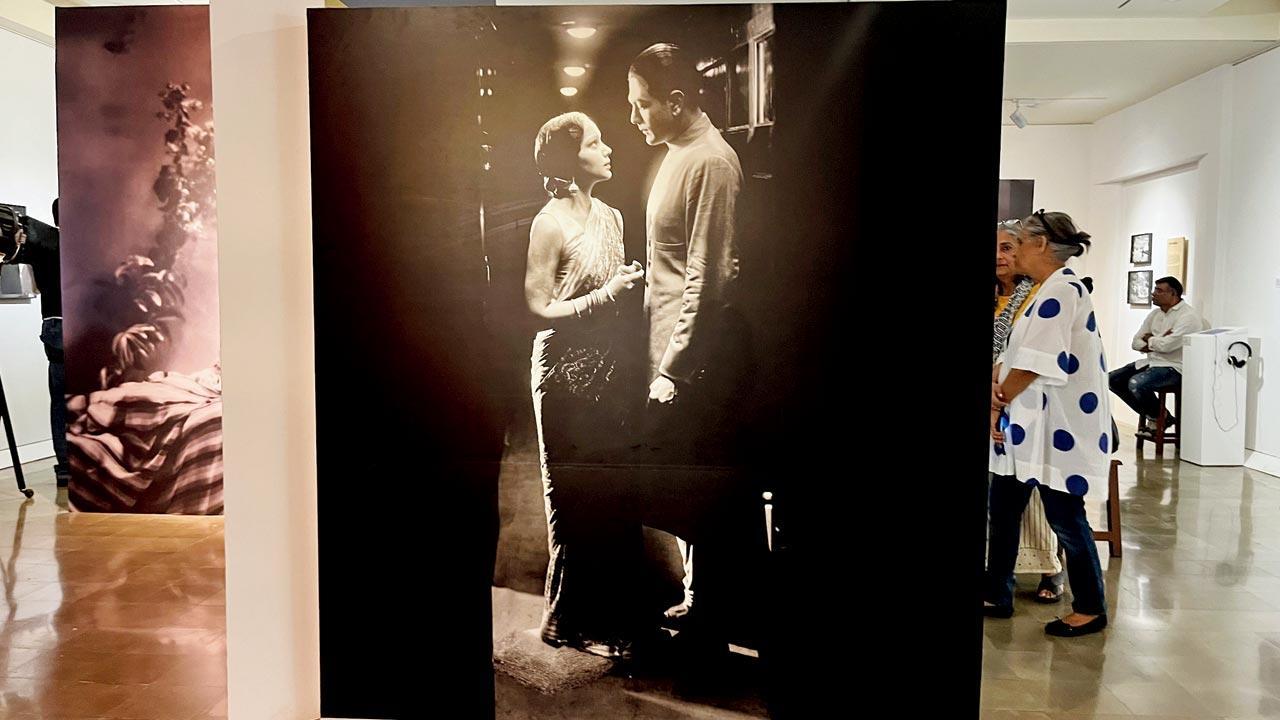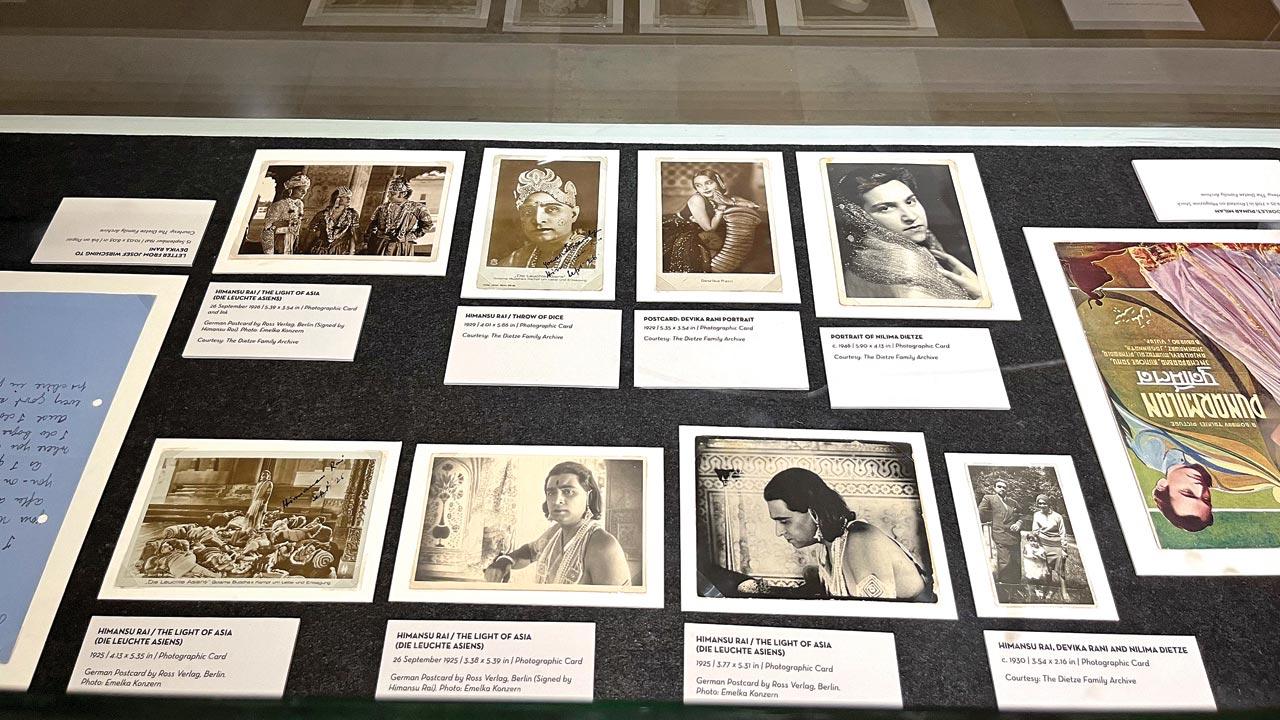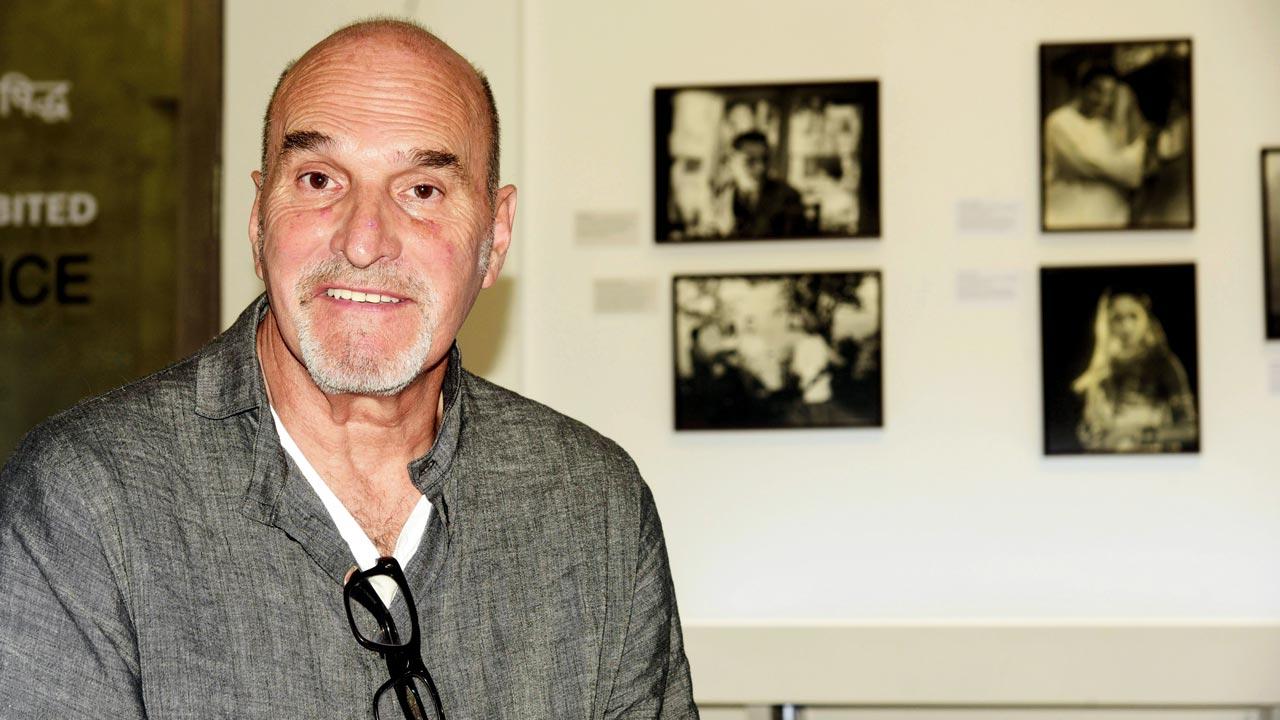Through a new exhibit in the city, Himansu Rai’s grandson continues to trace the cinema veteran’s journeys, and his own roots. And it all started with a picture he found in the attic at 30

A Cinematic Imagination at the JNAF gallery is a tribute to Josef Wirsching, a cinematographer and still photographer who worked at Bombay Talkies. Pics/Atul Kamble
It's no ordinary day at the Chhatrapati Shivaji Maharaj Vastu Sangrahalaya. The newly-opened, ambitious exhibition, titled A Cinematic Imagination: Josef Wirsching and the Bombay Talkies, has turned the walls of its Jehangir Nicholson Art Foundation gallery into an arena where Devika Rani, a luminous screen presence and the biggest star of the 1930s, has come to life. In two stills placed side by side, she looks coy and naughty respectively, her eyes transfixed on the viewer’s own. A relative of the Tagores and the face of box office hits like Achhut Kanya and Izzat, Rani is also remembered for her marriage to director Himansu Rai, with whom she ran the pioneering Bombay Talkies studio.
Peering closely at a cutout of the actress is Peter Dietze, a Melbourne-based visual artist. Does he think Rani and his grandmother, Mary Hainlin, knew each other? “Absolutely—of course they did. There are pictures of Mary, my mother and Himansu together, one of which is on display here. It was a crazy time in the Roaring Twenties,” Dietze remarks.
 Artefacts from the Dietze Family Archive
Artefacts from the Dietze Family Archive
Though Rai and Rani did not have children, the director was briefly married to German stage actress Hainlin. The thing that has brought Dietze to India many times over in the last 30 years is a lesser-known truth: he is among three of Himansu Rai’s only descendants, through Hainlin and her daughter Nilima. The visual artist believes Hainlin had much to do with Rai’s bohemian exposure to German theatre and cinema—crucial to the director’s long-term partnerships with collaborators like Franz Osten. “We have a photo of Hainlin with Fritz Lang,” he shares.
Dietze never had a chance to meet his grandmother Mary, who passed away before his birth. His mother Nilima moved from war-torn Germany to Australia in the early 1950s—a time when a “Whites-only” immigration policy was in place. The result was that she denounced her Indian heritage and was perceived as only German. Born and raised in Australia, Dietze refused his mother’s encouragement to learn German—the language spoken at home—as a young child.
 The Dietze Family Archive is an expansive, 3,000-odd item repertoire which includes letters, booklets, bills and news clippings
The Dietze Family Archive is an expansive, 3,000-odd item repertoire which includes letters, booklets, bills and news clippings
“I had no knowledge whatsoever of my Indian background at the time. I only discovered it in the 1980s, when I was in my 30s, thanks to a photograph lying in the attic of our house. The man in the photograph—who I later learnt was Rai—looked like me. My instantaneous response was to ask, is this my grandfather?” the visual artist recalls, “Perhaps until then I had no real understanding of who I was. It’s only during moments like this that you discover where you came from, and why you behave the way you do.”
In retrospect, Dietze can see glimpses of Rai in himself through the different artefacts he has encountered—and in their noses. There’s also his rebellious side (he refers to himself as a loose cannon) and his hunger to explore the world. His ability to look at his own grandfather’s life story with objectivity is admirable. In his first conversation with this writer, the Melbourne resident acknowledged that Rai was something of a “rogue”—not the easiest person to know or get along with—who did what it took to make things work. “He was an undoubtedly complicated person… He spent a lot of time putting together pennies given that he was working on expansive projects like Light of Asia [a 1925 film whose budget is estimated to be R1 lakh at the time of its making],” he says.
 It was only in his 30s that Peter Dietze learnt of his connection to Himansu Rai, many continents away
It was only in his 30s that Peter Dietze learnt of his connection to Himansu Rai, many continents away
Dietze watches over a vast archive of telegrams, screenplays, invitations, news clippings and other artefacts from the Bombay Talkies era, many of which were once owned by Devika Rani and pertain to the period when she ran the studio following Rai’s death. She took these belongings with herself after she quit the studio. Later in life, she had them sent to the Nicholas Roerich Museum, an institution devoted to the Russian painter’s works (Rani was married to his son, Svetoslav). The late Daniel Entin, former director at the museum, had been communicating with Dietze since the early 2000s, when he discovered that the visual artist and his siblings were Rai’s only descendants.
Entin wanted to hand over the artefacts to Dietze, but the latter took some time to wrap his head around the generous offer—as a way of coming one step closer to his grandfather’s legacy. “They were gifted to me; they belong to our family. I’m only the custodian of something that should eventually end up in India,” he says in reflection. Dietze hopes to showcase the artefacts in an exhibition focused on Rai and Bombay Talkies in the future, when he has the financial backing to match his vision.
Any exhibition of Bombay Talkies artefacts from The Dietze Family Archive allows for a very limited showing of what is an expansive, 3,000-odd item repertoire—which includes articles like the receipt for a bottle of wine purchased by Rai in Germany. The ongoing one at the JNAF, focused on Josef Wirsching’s life, brings forth about a dozen items. These include pictures of Rai and Rani in character, a letter Rai wrote to Fritz Lang seeking his support, and booklets of films like Jeevan Prabhat.
A Cinematic Imagination gave Dietze his first opportunity to meet the siblings Josef (Jr) and Georg Wirsching, grandchildren of cinematographer and still photographer Josef Wirsching. It is Wirsching’s keen eye for documentation that has shown us Bombay Talkies’ inside world, its elaborate sets and infrastructure, and the lives of its actors and crew. The exhibition is composed of the black and white stills he took as an employee of the German production company Emelka Film Studios and Bombay Talkies.
“We’ve corresponded before about the archive in Melbourne, and in the past, I’ve sent them material pertaining to their family. But this is the first time that the two archives are coming together,” Dietzes notes, “The work of the two Wirsching brothers is bringing their grandfather from the background to the foreground, which is the way things should be done today. The hard work was also being done by those in film crews, but attention seems to be paid only to the actors.” Debashree Mukherjee explains that this juxtaposition of the archives has allowed her and exhibition co-curator Rahaab Allana of the Alkazi Foundation for the Arts to piece together hitherto unknown details.
In his early days of acquainting himself with his grandfather, Dietze was met with a measure of disappointment: When he’d quiz Indian taxi drivers in Australia about whether they knew of Himansu Rai, the answer was always, no. Now, he is able to take pride in the relevance that Rai’s films have enjoyed more recently, as old prints are restored. Films like Shiraz: A Romance of India have lived out a second life through experimental projects, like the screenings which were held a few years ago, accompanied by a live music score from Anoushka Shankar.
“I wanted to retrace the journeys my grandfather took, and the process has made it very hard to go back to Australia,” Dietze confesses, imagining exciting mornings at the studio in Malad, and lavish evenings spent at the Taj Mahal Palace Hotel. This was a challenge in the 1980s, without the Internet. “Devika Rani was still alive, but my only references were one book in an Australian library and a film or two. I think in pushing and pursuing memories I opened up a Pandora’s Box in the family because it wasn’t easy for my Mum, who didn’t see her father after she turned five... Now, all I want to do is explore my ancestry—it’s inescapable now,” he says.
“His filmography is being embraced by new, young audiences—it’s not the stuff of scratchy old film tapes,” Diezte says, adding that he is taking a “preserve, educate, promote” approach to his grandfather’s legacy. His partners in this mission are his brothers Walter and Paul, and their extended family. And fittingly, a grandfather himself, Dietze is passing on the Bombay Talkies legacy to his grandchildren.
 Subscribe today by clicking the link and stay updated with the latest news!" Click here!
Subscribe today by clicking the link and stay updated with the latest news!" Click here!










